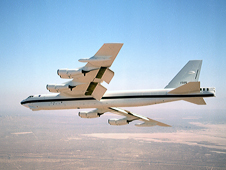- NASA Home
- | Centers
- | Dryden Home
- | News
- | Fact Sheets
Search Dryden
Fact Sheets
B-52H Air-Launch and Research Testbed
03.22.07
 NASA Dryden's fabrication branch built a new, in-house designed pylon for the B-52H to carry aerospace test vehicles aloft. The new pylon was designed with the flexibility to adapt to the variety of aerospace vehicle shapes and sizes, and could carry a load weighing up to 25,000 pounds.
NASA Dryden's fabrication branch built a new, in-house designed pylon for the B-52H to carry aerospace test vehicles aloft. The new pylon was designed with the flexibility to adapt to the variety of aerospace vehicle shapes and sizes, and could carry a load weighing up to 25,000 pounds.
Image right: NASA Dryden's B-52H in flight. NASA photo by Jim Ross
The B-52H, USAF serial number 61-0025, arrived at NASA Dryden on July 30, 2001 from the USAF's 23rd Bomb Squadron, 5th Bombardment Wing, located at Minot AFB, North Dakota. Initially placed on loan, the aircraft was later transferred from the USAF to NASA.
At present, NASA is performing design, analysis, and testing leading up to a Critical Design Review at the end of 2007. As part of the preliminary studies, several "captive-carry" flights will be flown by the F-15 with an inactive missile with no propellant carried on the aircraft's centerline pylon to determine the performance of the aircraft when carrying the missile. The project has not been funded to conduct actual launches to obtain hypersonic flight test data, and a decision on funding such research is not expected before 2008.
Following de-militarization and programmed depot maintenance at Tinker Air Force Base, Okla., a flight research instrumentation package was then installed on the aircraft, as well as other modifications to support its launch platform role.
The B-52H was intended to replace Dryden's famous B-52B "008", which was retired on Dec. 17, 2004. However, with no research projects requiring its capabilities on the horizon under NASA's restructured aeronautics research programs, the decision was made to return the aircraft to the Air Force, which intends to use it as a training aid for B-52 ground technicians. Physical transfer of the aircraft is expected to occur in mid-2007.
Aircraft Specifications
Contractor: Boeing Military Airplane Co.
Engines: Eight Pratt & Whitney TF33-P-3/103 turbofan engines
Thrust: Each engine up to 17,000 pounds
Length: 159 feet, 4 inches (48.5 meters)
Height: 40 feet, 8 inches (12.4 meters)
Wingspan: 185 feet (56.4 meters)
Maximum never-exceed speed: 650 miles per hour (Mach 0.86)
Ceiling: 50,000 feet (15,151.5 meters)
Weight: Approximately 185, 000 pounds empty (83,250 kilograms)
Maximum Takeoff Weight: 488,000 pounds (219,600 kilograms)
Range: Unrefueled 8,800 miles (7,652 nautical miles)